#NGC 4388
Photo
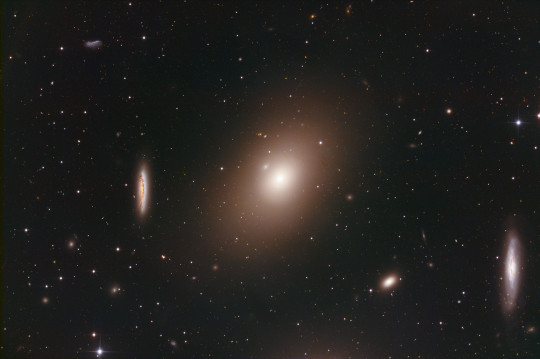
M86 // Maxim Usatov
#astronomy#astrophotography#galaxy#elliptical galaxy#messier#messier 86#M86#NGC 4406#NGC 4402#NGC 4387#IC 3355#NGC 4388#virgo
57 notes
·
View notes
Photo
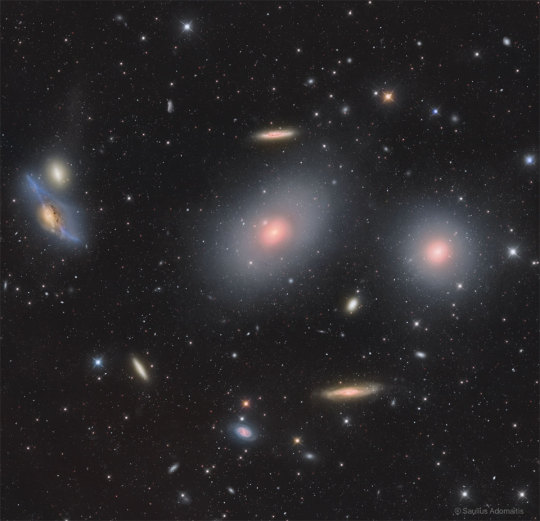
2022 June 15
In the Heart of the Virgo Cluster
Image Credit & Copyright: Saulius Adomaitis
Explanation: The Virgo Cluster of Galaxies is the closest cluster of galaxies to our Milky Way Galaxy. The Virgo Cluster is so close that it spans more than 5 degrees on the sky - about 10 times the angle made by a full Moon. With its heart lying about 70 million light years distant, the Virgo Cluster is the nearest cluster of galaxies, contains over 2,000 galaxies, and has a noticeable gravitational pull on the galaxies of the Local Group of Galaxies surrounding our Milky Way Galaxy. The cluster contains not only galaxies filled with stars but also gas so hot it glows in X-rays. Motions of galaxies in and around clusters indicate that they contain more dark matter than any visible matter we can see. Pictured here, the heart of the Virgo Cluster includes bright Messier galaxies such as Markarian's Eyes on the upper left, M86 just to the upper right of center, M84 on the far right, as well as spiral galaxy NGC 4388 at the bottom right.
∞ Source: apod.nasa.gov/apod/ap220615.html
46 notes
·
View notes
Note
🎶✨️when u get this u have to put 5 songs u actually listen to, publish. Then, send this ask to 10 of your favorite followers (non-negotiable, positivity is cool)🎶✨️
Thanks for tagging @lil-melody ❤️💛🧡
So first let's celebrate whatever revolution is happening in Russia with gorgeous Go_A song called Rusalochki:
youtube
Swiernalis -NGC 4388, I'm unhealthily obsessed with this man recently:
youtube
Another Polish song, Kasia Lins - Wiersz ostatni
youtube
Extraliscio - Bianca luce nera - lovely Italo-latino song xd which for me is perfect for summer
youtube
And Lana del Rey - Happiness is a butterfly, recently recalled this song and found the lyrics really moving
2 notes
·
View notes
Photo
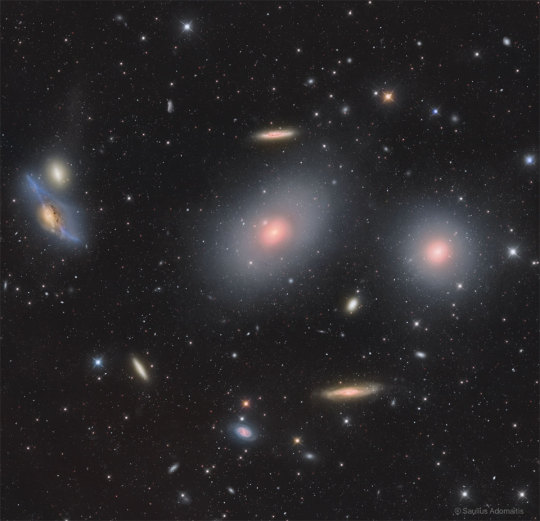
In the Heart of the Virgo Cluster via NASA https://ift.tt/Usp7tYS
The Virgo Cluster of Galaxies is the closest cluster of galaxies to our Milky Way Galaxy. The Virgo Cluster is so close that it spans more than 5 degrees on the sky - about 10 times the angle made by a full Moon. With its heart lying about 70 million light years distant, the Virgo Cluster is the nearest cluster of galaxies, contains over 2,000 galaxies, and has a noticeable gravitational pull on the galaxies of the Local Group of Galaxies surrounding our Milky Way Galaxy. The cluster contains not only galaxies filled with stars but also gas so hot it glows in X-rays. Motions of galaxies in and around clusters indicate that they contain more dark matter than any visible matter we can see. Pictured here, the heart of the Virgo Cluster includes bright Messier galaxies such as Markarian's Eyes on the upper left, M86 just to the upper right of center, M84 on the far right, as well as spiral galaxy NGC 4388 at the bottom right.
2 notes
·
View notes
Text
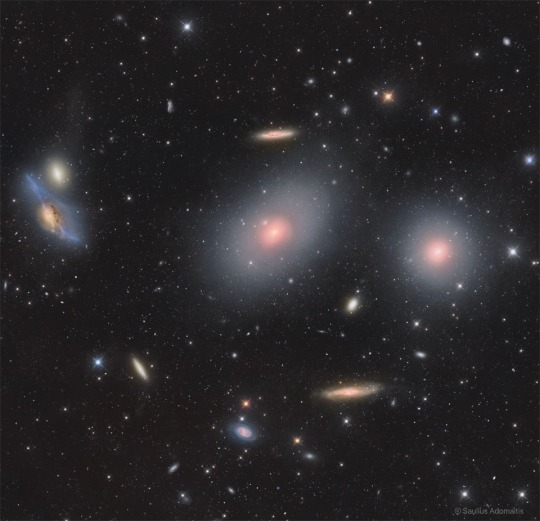
APOD: In the Heart of the Virgo Cluster (6/15/22)
The Virgo Cluster of Galaxies is the closest cluster of galaxies to our Milky Way Galaxy. The Virgo Cluster is so close that it spans more than 5 degrees on the sky - about 10 times the angle made by a full Moon. With its heart lying about 70 million light years distant, the Virgo Cluster is the nearest cluster of galaxies, contains over 2,000 galaxies, and has a noticeable gravitational pull on the galaxies of the Local Group of Galaxies surrounding our Milky Way Galaxy. The cluster contains not only galaxies filled with stars but also gas so hot it glows in X-rays. Motions of galaxies in and around clusters indicate that they contain more dark matter than any visible matter we can see. Pictured here, the heart of the Virgo Cluster includes bright Messier galaxies such as Markarian's Eyes on the upper left, M86 just to the upper right of center, M84 on the far right, as well as spiral galaxy NGC 4388 at the bottom right. Celestial Surprise: What picture did APOD feature on your birthday? (post 1995) Birthday?
© Saulius Adomaitis
0 notes
Photo
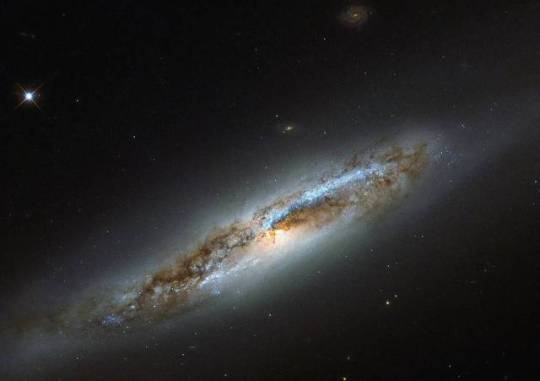
NGC 4388
This is an unusual spiral galaxy that has been warped by interactions with surrounding galaxies. Its nestled in the Virgo Cluster, with over 1,300 other galaxies. Some survive the collisions, while others are pulled apart.
#ngc 4388#virgo cluster#virgo constellation#hubble#NASA#NASA/ESA#astronomy#space blog#nature#spiral galaxy#unusual galaxy#mine
330 notes
·
View notes
Photo
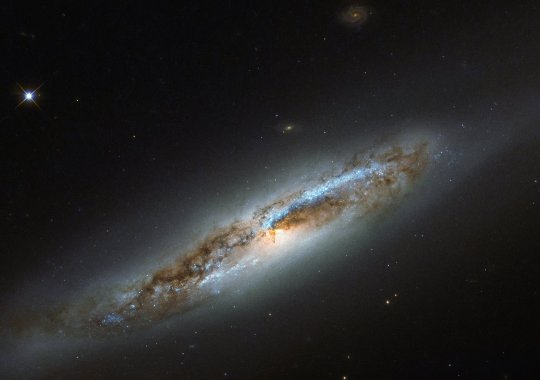
NGC 4388, captured by the NASA/ESA Hubble Space Telescope. A member of the Virgo constellation.
article
#nasa#space#galaxy#NGC 4388#photo#photography#hubble#hubble photo#telescope#hubble telescope#virgo#virgo constellation
1 note
·
View note
Photo
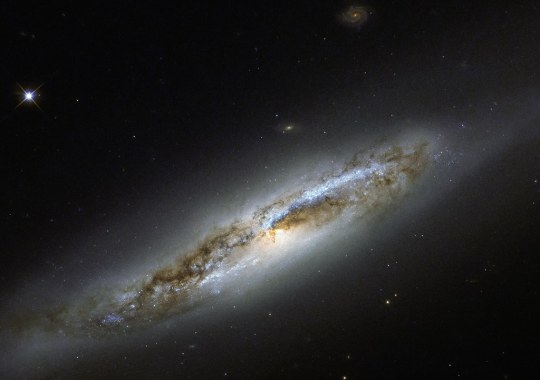
The Peculiar Virgo Cluster Galaxy NGC 4388 by NASA Hubble
218 notes
·
View notes
Photo
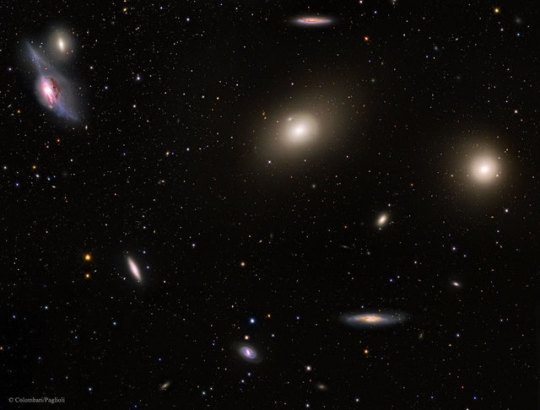
In the Heart of the Virgo Cluster : The Virgo Cluster of Galaxies is the closest cluster of galaxies to our Milky Way Galaxy. The Virgo Cluster is so close that it spans more than 5 degrees on the sky - about 10 times the angle made by a full Moon. With its heart lying about 70 million light years distant, the Virgo Cluster is the nearest cluster of galaxies, contains over 2,000 galaxies, and has a noticeable gravitational pull on the galaxies of the Local Group of Galaxies surrounding our Milky Way Galaxy. The cluster contains not only galaxies filled with stars but also gas so hot it glows in X-rays. Motions of galaxies in and around clusters indicate that they contain more dark matter than any visible matter we can see. Pictured above, the heart of the Virgo Cluster includes bright Messier galaxies such as Markarians Eyes on the upper left, M86 just to the upper right of center, M84 on the far right, as well as spiral galaxy NGC 4388 at the bottom right. via NASA
js
902 notes
·
View notes
Photo
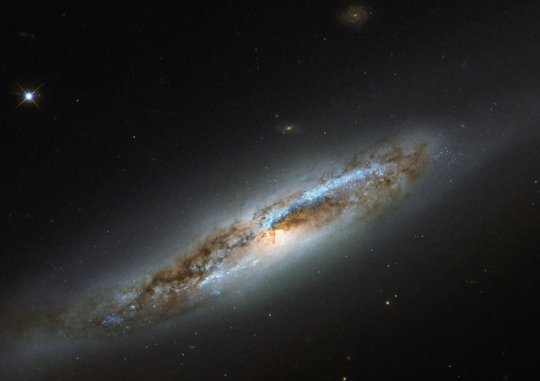
A transformation in Virgo
The constellation of Virgo (The Virgin) is especially rich in galaxies, due in part to the presence of a massive and gravitationally-bound collection of over 1300 galaxies called the Virgo Cluster. One particular member of this cosmic community, NGC 4388, is captured in this image, as seen by the NASA/ESA Hubble Space Telescope’s Wide Field Camera 3 (WFC3).
Located some 60 million light-years away, NGC 4388 is experiencing some of the less desirable effects that come with belonging to such a massive galaxy cluster. It is undergoing a transformation, and has taken on a somewhat confused identity.
While the galaxy’s outskirts appear smooth and featureless, a classic feature of an elliptical galaxy, its centre displays remarkable dust lanes constrained within two symmetric spiral arms, which emerge from the galaxy’s glowing core — one of the obvious features of a spiral galaxy. Within the arms, speckles of bright blue mark the locations of young stars, indicating that NGC 4388 has hosted recent bursts of star formation.
Despite the mixed messages, NGC 4388 is classified as a spiral galaxy. Its unusual combination of features are thought to have been caused by interactions between NGC 4388 and the Virgo Cluster. Gravitational interactions — from glancing blows to head-on collisions, tidal influencing, mergers, and galactic cannibalism — can be devastating to galaxies. While some may be lucky enough to simply suffer a distorted spiral arm or newly-triggered wave of star formation, others see their structure and contents completely and irrevocably altered.https://www.spacetelescope.org/images/potw
#space#astronomy#space images#space pictures#astrophotography#space--bot#science#Id#potw1649a#Type#Observation#Release#date#5#December#2016#0600#Size#3807#2679#Name#NGC#4388#Local#Universe#Spiral#Distance#60
74 notes
·
View notes
Text

Markarian's Chain 😐 // Bryan Wilmoth
Some of the galaxies in this image include: M84, M86, NGC 4388, The Eyes (NGC 4438), NGC 4461, and NGC 4458.
#astronomy#astrophotography#galaxy cluster#virgo cluster#galaxy#spiral galaxy#elliptical galaxy#peculiar galaxy#interacting galaxies#eyes galaxies#NGC 4435#NGC 4438#Arp 120#messier#messier 84#M84#messier 86#M86#NGC 4374#NGC 4406#NGC 4388#NGC 4461#NGC 4458#virgo
42 notes
·
View notes
Photo
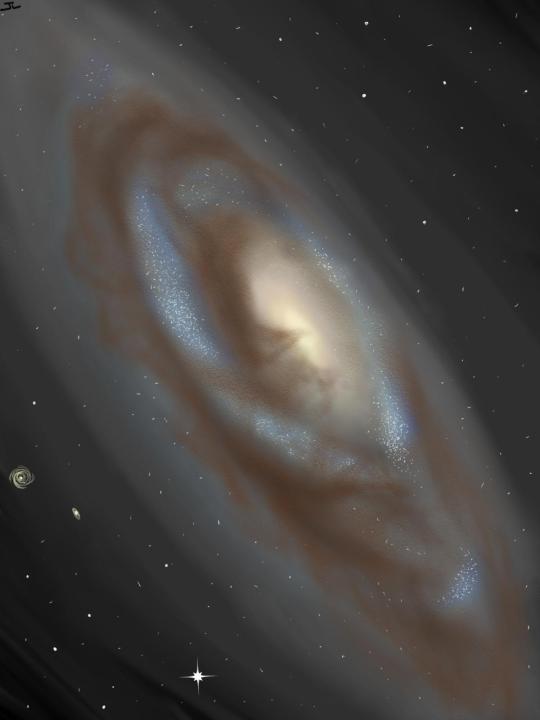
Recently, I’ve rediscovered my love for space and the universe beyond our little blue rock, so here’s a galaxy!! I think it came out rather well considering my previous attempts at space lmao
This galaxy is NGC 4388, an unusual spiral galaxy :)
(source)
click for better quality
0 notes
Photo

The constellation of Virgo (The Virgin) is especially rich in galaxies, due in part to the presence of a massive and gravitationally-bound collection of more than 1300 galaxies called the Virgo Cluster. One particular member of this cosmic community, NGC 4388, is captured in this image, as seen by the NASA/ESA Hubble Space Telescope’s Wide Field Camera 3.
Located some 60 million light-years away, NGC 4388 is experiencing some of the less desirable effects that come with belonging to such a massive galaxy cluster. It is undergoing a transformation and has taken on a somewhat confused identity.
While the galaxy’s outskirts appear smooth and featureless, a classic feature of an elliptical galaxy, its center displays remarkable dust lanes constrained within two symmetric spiral arms, which emerge from the galaxy’s glowing core — one of the obvious features of a spiral galaxy. Within the arms, speckles of bright blue mark the locations of young stars, indicating that NGC 4388 has hosted recent bursts of star formation.
Despite the mixed messages, NGC 4388 is classified as a spiral galaxy. Its unusual combination of features are thought to have been caused by interactions between NGC 4388 and other galaxies in the Virgo Cluster. Gravitational interactions — from glancing blows to head-on collisions, tidal influencing, mergers, and galactic cannibalism — can be devastating to galaxies. While some may be lucky enough to simply suffer a distorted spiral arm or newly-triggered wave of star formation, others see their structure and contents completely and irrevocably altered.
1 note
·
View note
Photo
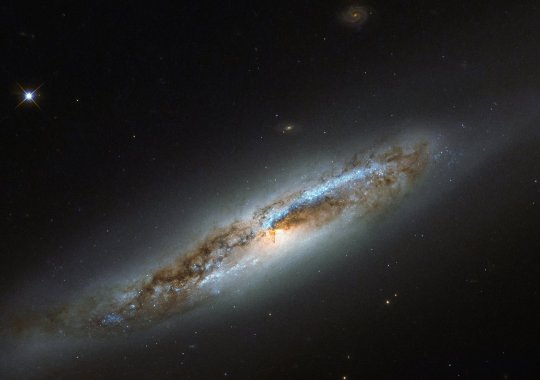
One member of the Virgo Cluster, NGC 4388, as seen by the NASA Hubble Space Telescope.
Source: Hubble
29 notes
·
View notes
Text
Особые отношения в кластере Девы
http://astro-analytics.net
Ученые изучают одну из галактик в кластере Девы.
Зодиакальное созвездие Девы особенно богато на галактики. Здесь находится как минимум 1300 гравитационно связанных галактик. Одним из особенных членов этого гигантского галактического кластера является галактика известная под обозначением NGC 4388. Она была сфотографирована широкоугольной камерой Wide Field Camera 3 (WFC3), установленной на борту космического телескопа имени Хаббла. Это удивительное изображение можно увидеть ниже.
Галактика NGC 4388 находится на расстоянии 60 миллионов световых лет от Земли. Данная галактика претерпевает некоторые изменения. впорочем, как и многие прочие галактики, принадлежащие такому массивному галактическому скоплению, как кластер Девы. Все дело в том, что взаимодействия между членами подобных кластеров довольно сложные. А изменения в одной галактике возможно станут причиной изменений в другой гравитационно связанной галактике.
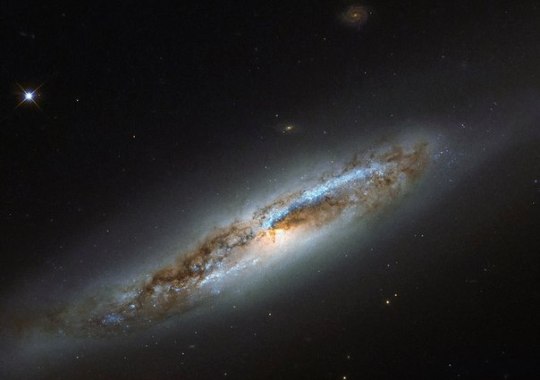
0 notes
Text
Hubble Catches a Transformation in the Virgo Constellation
Hubble Catches a Transformation in the Virgo Constellation
This image was taken in 2017. It still blows our mind.
Hubble Catches a Transformation in the Virgo Constellation
The constellation of Virgo (The Virgin) is especially rich in galaxies, due in part to the presence of a massive and gravitationally-bound collection of more than 1300 galaxies called the Virgo Cluster. One particular member of this cosmic community, NGC 4388, is captured in this image,…
View On WordPress
0 notes